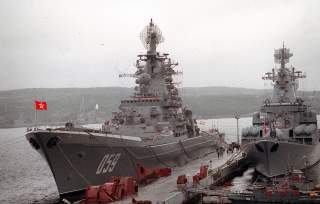The U.S. Military Made a Big Mistake When It Came to Russia's Cold War Navy (And Might Repeat It with China)
It seems history could very well rhyme after all.
Back in the 1980s, a war with the Soviet Union seemed like a naval nightmare.
Fiction writers like Tom Clancy and John Hackett painted a future where Western navies faced hordes of Red bombers, cruise missiles, submarines and surface warships. Naturally, in these novels the Good Guys won, but only at tremendous cost.
In hindsight, some of this looks silly. We know now—and some suspected back then—that the Soviet Navy was undercut by major deficiencies in technology and training. It was no paper tiger, but neither was it some aquatic beast that would have devoured Western fleets.
Are we now making the same mistake with China? When we read reports of a vast expansion in China’s navy, or of alleged Chinese superweapons like carrier-killer ballistic missiles, are we exaggerating the threat?
First, it’s important to realize that shock is not conducive to rational thinking. From 1917 through the early 1960s, the Soviet Navy was not a serious threat to the West. It was a large but limited fleet, primarily oriented toward coastal defense, with lots of small missile boats, torpedo boats and diesel submarines. It was the massive Red Army that provided the muscle behind Moscow’s military might.
By the late 1960s, under the leadership of Adm. Sergei Gorshkov, the Soviet Navy turned hard about. Instead of mere coastal defense, Moscow began building a blue-water navy that comprised major surface combatants such as heavily armed cruisers and destroyers, nuclear attack submarines, and—horrors!—even aircraft carriers, the ultimate symbol of seapower in Western eyes. Even if the Soviets couldn’t defeat the U.S. and allied navies in an absolute sense, perhaps they could sink the troop convoys ferrying U.S. reinforcements across the Atlantic and thus allow the Red Army to overrun Europe, or destroy the oil tankers that kept Western economies running.
However, it turns out that the Soviet Navy had severe problems. Ships were not mechanically reliable, nor even safe (“How do you know a Soviet submarine sailor? He glows in the dark”). Morale was not particularly high, as evidenced by that Soviet destroyer that tried to defect to the West in 1975.
If this sounds familiar, then it’s because Communist China was never reckoned a formidable naval power until perhaps the beginning of the twenty-first century. Now, China is seen to have advanced weapons, a strategy for contesting control of the Western Pacific and—horrors!—even an aircraft carrier. And we know that China still has a ways to go before it creates a top-notch navy, such as learning to operate an aircraft carrier.
Russian naval power dates back to the seventeenth century and Peter the Great, while Chinese explorers sailed as far as Africa and Australia centuries before Columbus managed to reach America. Nonetheless, neither the Soviet Union nor Communist China has had a tradition of operating fleets at sea for long periods under adverse conditions of combat or weather. Whatever flaws the U.S. and British navies have, such as questionable and overpriced ship and aircraft designs, both have vast amounts of experience, and both have strong traditions of victory. There is more to winning a war at sea than numbers of ships or missiles.
There is something else that we learned during the Cold War: assessment drives acquisition. Either a nation acquires more arms, out of fear that its enemies have more or better weapons, or its leaders whip up such fear to justify defense spending because of domestic politics. Either way, Ronald Reagan lead the United States into a massive arms buildup to counter what was seen to be as overwhelming Soviet military power. Trillions were spent on aircraft carriers, submarines and other advanced weapons.
America is building $13 billion Ford-class aircraft carriers, among other weapons, largely out of concern that China threatens U.S. dominance of the seas. In fact, the Navy’s new plan to build up a 355-ship navy means the United States is poised to embark on its largest expansion since the end of the Cold War. If a Sino-American conflict erupts, and Chinese naval power is as strong as some fear, it will have been a worthwhile investment.
However, if it turns out that China’s naval power has been overblown, and American defense dollars were better spent elsewhere—perhaps on aircraft, or drones, or cyberwarfare—then the Chinese navy will have won a victory even before the first shot is fired.
Michael Peck is a contributing writer for the National Interest. He can be found on Twitter and Facebook.
Image: The Russian nuclear-powered guided missile cruiser Kirov. Wikimedia Commons/U.S. Navy

